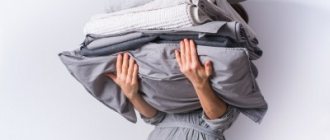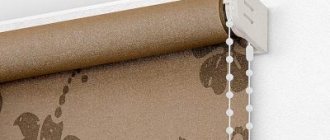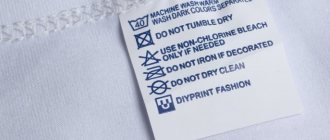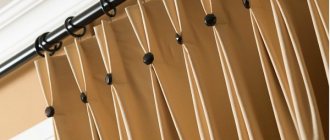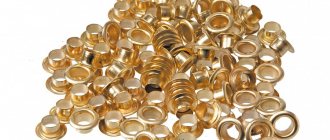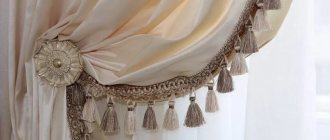The following liquid and gel detergents are recommended for washing in automatic washing machines: Flat, Selena, Dr. Beckman, Unicum and Cashmere. The optimum temperature is up to 40°C, and the washing temperature should be set for delicates, delicates, wool, silk and delicate fabrics. He hangs curtains on delicate fabrics without waiting for them to dry, and dries heavy curtains without twisting them, away from sunlight and heat. Use salt, baking soda and laundry soap to remove stains.
How often should curtains be washed?
How often you should wash your curtains depends on the occasion. Location is also important.
Wet cleaning of curtains in the kitchen should be done most frequently. They get dirty very quickly, and in addition to dust, fatty deposits accumulate in them. Therefore, kitchen curtains should be washed when they become dirty.
Curtains in other rooms should not be machine washed too often. Two washes per year is enough. The rest of the time, it is better to dry clean them to avoid the appearance of pests (for example, mites like to live in dusty places). To do this, you need to dry the curtains well, rub them through them and ventilate them.
On a note! Roller blinds can be vacuumed between washes.
However, if you do need to clean your curtains or drapes, make sure they are machine washable and read the cleaning instructions before putting them in the washing machine.
Is it possible to remove difficult stains?
They spoil the appearance of the products and the room as a whole, and create a bad mood for the hostess. There are many different ways to help remove stains of different origins. But general requirements must be met:
- first remove dust from the surface of stains,
- the lining on the curtain should be torn off,
- stains are removed with cotton swabs, the edges are sprinkled with starch,
- cleaning is carried out from the edge to the center of the contamination,
- The cleaned area is watered with warm water.
Which curtains are contraindicated for machine washing?
Chintz tulle is difficult to machine wash. It's best to wash your hands. Water for washing at room temperature should be slightly salted, and when rinsing, add table vinegar.
If your washing machine doesn't have wool, wash it by hand in 30°C water. Use only liquids and gels, avoiding loose powders.
Taffeta and nylon are too thin and delicate materials - the machine may break down, so it is better to prefer hand washing.
You can wash your blinds at home, but never in the washing machine.
If the type of fabric is unknown and cannot be determined, it is better not to machine them to avoid unpleasant consequences.
What's better
Typically, lightweight curtains made of synthetics or mixed materials are washed at home. Very heavy curtains made of velvet or brocade or very thin silk curtains, as well as those with decorative ornaments, embroidery, and those whose composition you do not know, are best left to specialists.
When it comes to choosing between hand and machine wash, it’s difficult to say which is better. Much depends on your physical capabilities - not every housewife will be able to wash pieces of fabric of such volume.
One thing is certain - washing should be gentle. It is more convenient to wash and soak by hand directly in the bath. In the case of machine washing, it is necessary to take into account both the degree of swelling of the material and the weight of the curtains when wet, so as not to damage the equipment.
Types of funds
To avoid damaging the curtains when washing, choose the appropriate type of detergent.
| No. | Name | Photo | Cost, rub. |
| 1. | Liquid detergent for delicate washing of curtains (blinds) and tulle Flat 0.5 l | 110–150 | |
| 2. | Selena for washing curtains and drapes 0.25 g | 110–150 | |
| 2. | Selena for washing curtains and drapes 0.25 g | 120–150 | |
| 3. | Shampoo for washing curtains Dr. Beckman 0.5 l | 130–180 | |
| 4. | Gel for washing tulle and curtains Unicum 0.75 l | 130–180 | |
| 4. | Gel for washing tulle and curtains Unicum 0.75 l | 170–200 | |
| 5. | Washing powder booster “Super white tulle plus” from Frau Schmidt in tablets (2 pcs.) | 80–100 | |
| 6. | Heitmann curtain detergent in sachets (5 pcs.) | 80–100 | |
| 6. | Heitmann curtain detergent in sachets (5 pcs.) | 280–300 | |
| 7. | Elixir for tulle and curtains “Cashmere” 0.3 g | 50–80 rub. |
Removing traces of coffee, tea and wine
Often, the curtain gets dirty with various drinks, and it is recommended to remove stains from them immediately. Your actions must be fast:
- the curtain is removed from the cornice,
- blot the stain with a napkin, treat with alcohol,
- prepare a solution - add a spoonful of vinegar and the same amount of dishwashing liquid to one liter of water,
- Before the main wash begins, the curtain is soaked in this solution for half an hour.
Sequence of steps when washing in a machine
Pay attention to preparing curtains for washing.
Make sure that the weight of the impregnated fabric does not exceed the maximum permissible weight of the device.
If eyelet curtains are to be washed, do not remove the accessories. Manufacturers often make them from high-quality raw materials, so they can withstand loads. But protect the surface of the drum by placing the item in a wash bag. After completing the “water treatment”, the curtains should be removed immediately so that the loops do not fade.
Important: if the cup is made of inexpensive plastic, remove the rings before washing.
Before washing blinds made from popular threads, make separate tight bundles of loose threads to make them easier to undo later. Place the curtain in a laundry bag or pillowcase to prevent the threads from getting tangled during washing.
Curtains with decorative accessories can also be washed in a bag.
Before loading into the machine, fold your clothes carefully to prevent the curtains from constantly folding.
We present the program
Select the most suitable washing programs: Hand wash, Delicate wash, Delicate wash, Wool, Silk, Delicates - examples of suitable washing programs in washing machines from various manufacturers.
Optimal temperature conditions
No type of fabric can damage temperatures of 30-35 °C.
Thick curtains are the least demanding. They can be washed in any wash cycle, at any temperature and with any detergent.
Blackout fabric
Black out textiles lead the market for materials used for sewing curtains. This is explained by the optimal combination of quality and price, practicality in use and ease of care, and the aesthetic properties of the material. Black out curtains do not allow street light to pass through at all, so it is advisable to use them in a bedroom or children's room. In addition, at the production stage, the fabric is impregnated with special substances that repel dust and dirt.
These curtains are washed at a water temperature of 40 °C, and you can use automatic spinning. If you hang the damp fabric on a curtain rod, you won't need to iron it.
If you follow the washing rules, home textiles will last for many years and will always have an attractive appearance.
Proper drying
For some housewives, light curtains do not dry, and immediately after washing they are hung on the window - they spread out under its weight, so there is no need to iron them.
Many housewives do not dry curtains, but immediately hang them on the window.
But in some cases you can’t do without drying. Firstly, there are several prohibitions:
- do not use an electric dryer,
- do not dry in direct sunlight or near heat sources,
- don't squeeze.
Let's move on to the drying process:
- After washing, straighten the curtains and hang them over the bathtub to drain water.
- Hang the dry but still damp product on the curtain rod hooks to dry.
- Light creases as it dries over the next 2-3 days.
Tip: If wrinkles remain, spray the curtain with plain water using a hand sprayer.
When drying outdoors, hang the item on several abrasive lines at the same time to avoid a clear crease line.
Velvet and velor are the most difficult fabrics to dry. After washing, wrap them in a towel or terry cloth and gently squeeze to remove excess moisture. Only then hang the curtains to dry.
Curtains that are too wrinkled should still be ironed.
How to wash without ironing?
Ironing curtains is a labor-intensive process. Therefore, every housewife should know how to wash them so that they do not wrinkle.
Step-by-step algorithm of actions:
- Wash the curtains in a washing machine without spinning or by hand without twisting the fabric.
- Allow the water to drain completely. When it stops dripping, shake the curtains thoroughly.
- Hang the curtains on the cornice while damp. Under their own weight, they will fully expand and take the desired shape.
If possible, immediately after washing the fabric is laid out on the floor, on a sheet or bedspread.
Ironing methods
The method of ironing the curtain after washing will depend on the material from which it is made:
- Iron the back of the curtains while they are still damp.
- When smoothing the seams, place gauze or a small piece of fabric between them and the fabric.
- Cotton and linen can be ironed using a high temperature iron.
- Velor and velvet can only be ironed dry and on the wrong side of the fabric, making sure that there is no steam on the iron.
- Synthetics and silk must be completely dry before ironing. These blinds are ironed on the reverse side of the fabric with minimal heat from the iron.
How to clean without removing from the curtain rod?
You can wash curtains without removing them from the curtain rod using a steam generator.
Instructions for use:
- Vacuum the curtains on both sides.
- Lather the sponge and rub the areas where there is dirt.
- Remove foam using a clean, damp microfiber cloth.
- Treat the curtains with a steam generator, moving it from top to bottom.
- Allow the fabric to dry on its own.
To ensure that there are no streaks left on the product after cleaning, the soaped areas must be washed thoroughly. Then the treated area is wiped with a dry, clean cloth.
Practical recommendations for removing contaminants
Kitchen blinds are the most susceptible to staining. But in homes where children live, it’s not just the curtains in the dining room that suffer from children’s hands. As soon as you notice a stain, begin removing it immediately. Getting rid of a fresh stain is much easier than dealing with old stains.
A new grease stain on tulle can be removed using dish soap. Apply it to the stain, wait a few hours and wash everything off.
An excellent way to combat stains is a concentrated soap solution for washing:
- Dissolve a quarter of a piece of grated or finely chopped laundry soap in 5 liters of water.
- Leave the curtains in the prepared liquid.
- Wash off after 3-5 hours.
Table salt has also proven to be an excellent way to combat various stains. Dissolve 1 tablespoon in 5 liters of water and place curtains in the solution for 2-4 hours. Rinse under running cool water. Let dry.
Grease and yellowing can be treated well with a baking soda solution. Dissolve 50 g of washing powder and a tablespoon of baking soda in 5 liters of water. Soak the tulle for 20-25 minutes. Wash it.
There are even more folk ways to whiten tulle.
Oxygen-free chlorine-free bleach can be used:
- OxyCrystal;
- "Bos";
- "Persol";
- "Ecostar";
- Flat;
- "Big Wash".
Preparation
The preparatory stage is very important and the final result also depends on it. To begin with, the curtains should be shaken well (it is better to do this outside) to remove all accumulated dust. Canvases with eyelets must not be shaken out, so you can use a vacuum cleaner. Be sure to inspect the curtains for stains and heavy dirt. If they are, move on to the next stage.
Washing items with stains or traces of grease cannot be done without soaking. Add a suitable product to a bowl of cool or warm water and leave for 30-60 minutes. It is not advisable to rub them, otherwise there is a risk of damaging the fabric fibers. You can raise and lower the curtains into the basin several times to create foam. All that remains is to rinse the curtains in clean water and proceed to the main stage.
Useful tips
There are several techniques that will help you achieve maximum cleaning effect:
- Do not wash curtains together with curtains or other items.
- Use the Extra Rinse function, especially if you are using regular granular powder.
- If the curtains have not been washed in several years and are very dirty, soak them first.
- When using detergent, make sure you read the instructions for use.
- For best cleaning, make sure the drum is only half full.
Removing grease stains
It is necessary to remove a grease stain immediately, while it is fresh and easier to deal with. There are several ways to do this:
- the stain is sprinkled with talcum powder or starch. White paper is placed under the fabric, the stain is sprinkled and left for a day,
- effectively removes grease stains with the pulp of black bread,
- the stain is removed with chalk or tooth powder,
- old grease stains are removed with ammonia or glycerin.
Tactics and nuances
When cleaning a curtain using a “folk” remedy for the first time, it is better to try it on a small, inconspicuous area of the material. If a substance harms the product, its use should be discontinued. As already mentioned, it is forbidden to wash thread curtains with beads, sequins, and bugles in an automatic machine. There is no need to choose dry powders, especially those with colored granules. This may leave marks on the fabric.
Bright rope curtains cannot be cleaned with products containing bleaching components; compositions should be selected for colored linen. When rinsing synthetic curtains, it is advisable to add an antistatic conditioner to the water.
When deciding to wash filament curtains, you need to take into account a number of nuances.
- The water into which cotton and linen curtains are immersed should not be hotter than 30°C.
- Be sure to braid the muslin into braids or collect the threads in several bundles, otherwise the strands will become very tangled with each other.
- Do not wring out rope drapes.
- Dry draperies naturally - on the curtain rod. Do not place them on a radiator or electric dryer.
When the curtains are washed and hung back on the curtain rod, do not rush to remove all the ribbons at once. You need to untangle each braid or bun one by one, carefully straightening the threads along the entire length. This must be done from top to bottom. To remove difficult stains, you can use special household chemicals. When using products, strictly follow the manufacturer's instructions.

